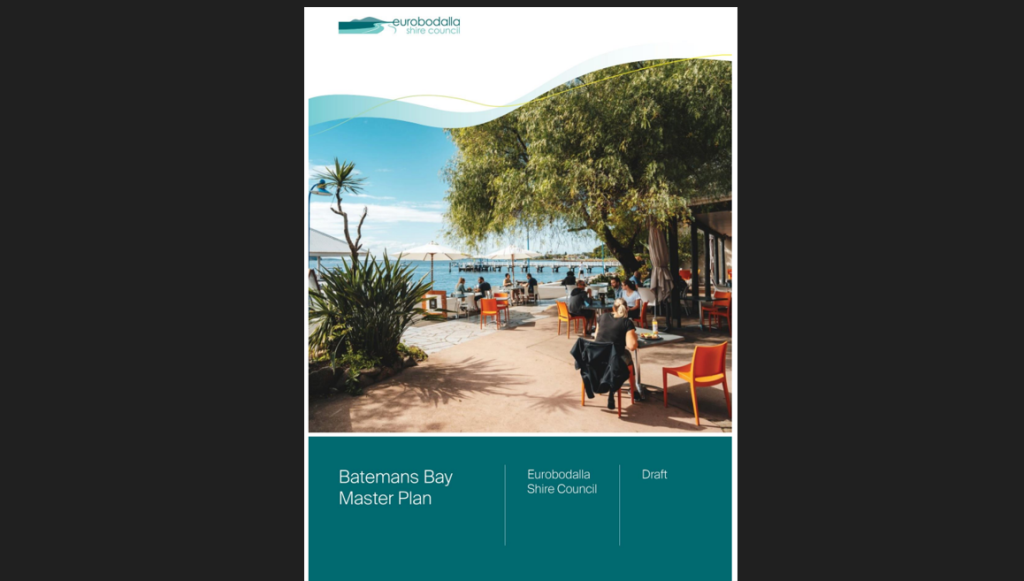Letter to the Editor - Draft Batemans Bay Master Plan

I read the draft Batemans Bay Master Plan with increasing incredulity at its lack of rigour and denial of reality. It is a planning fantasy which is full of esoteric notions of architectural beauty and high-minded planning principles that have the capacity to transform Batemans Bay into a ‘beautiful, vibrant, sustainable and inclusive town’ which ‘meets the communities’ needs and addresses climate change’. This is despite the fact that the draft plan shows no evidence of having consulted the community during its preparation and does not consider the potential impacts that a changing climate will have on this very vulnerable coastal town.
My main concerns with the draft Master Plan are as follows:
It appears to exist in a planning vacuum. It does not reference any other plans that may be of relevance to it including regional plans such as the SE & Tablelands Regional Plan or the recently released ‘Blueprint for a Resilient SE NSW’. Nor does it refer to relevant Council plans such as the Coastal Management Plan or the Climate Action Plan or even the 2015 Greater Batemans Bay Structure Plan, which was the result of extensive community consultation.
It essentially ignores the ‘Elephant in the Room’, Climate Change, which represents a very real risk to Batemans Bay that sits ‘where the Clyde River meets the Pacific Ocean’. This is despite the fact that other low lying coastal towns in NSW have suffered immense and very costly damage in recent times due to extreme weather events attributable to climate change. Unbelievably, the draft Master Plan proposes high rise developments in extremely vulnerable waterfront areas but concedes that there will be ‘a need for above-ground parking due to flooding risks, which complicates development and increases the need for taller buildings’! It goes on to suggest that Beach Road could be ‘raised to serve as a key sea wall defence’ for the residential high rise that it proposes along the foreshore. How will this be achieved in practice, how much will it cost and who will pay? I am amazed that a plan with such a ridiculously long timeframe of 75 years does not even bother to consider where the sea level might be by 2100.
The other jaw dropping aspect of this draft Master Plan is that it actually locates the majority of its ’ landmark’ and ‘gateway’, as well as high rise residential development, in areas that are mapped as being within the Probable Maximum Flood zone in Council’s own mapping based on current day conditions, which are only likely to be ramped up. In its only recognition of this challenge it states that ‘coastal protection and inundation management’, will be required ‘to protect businesses from flood and stormwater inundation’. Really, and who will pay for this? How will these buildings get insurance and how much will it cost?
In addition to placing very tall buildings in extremely risky locations, it does not even consider the challenges of constructing these buildings in the first place. Stunningly, there is no acknowledgment of the difficulties that were faced in constructing foundations for the Bay Pavilions and the Village complex which occur on unconsolidated sediments adjacent to mangroves at the mouth of the ClydeRiver. These structures are relatively modest in terms of height, so what can we expect when investigations begin into the feasibility of constructing the towering ‘gateway’ or ‘landmark’ buildings alongside them? Will there be any developers crazy enough to take on this challenge?
The draft Master Plan reads like a graduate student’s planning assignment in terms of the jargon it contains as well as the building aesthetics and planning ideals it refers to. It has no basis in reality in terms of what is there currently and the amount of work and costs involved in making the marvellous transformation it describes, which involves relocating shopping centres and demolishing existing buildings. This grand plan does it all, although I note that most of the examples in photos of what will be achieved are from overseas. It argues that the ‘gateway sites on the southern end of the Clyde Bridge are crucial in establishing the town’s visual identity, aspiring to beautifully designed spaces’. I would argue that the stunning natural setting of Batemans Bay establishes the town’s visual identity and it is that which primarily attracts tourists, not some large towers which will make Batemans Bay look just like the CBD of the cities from which these tourists are escaping. There is no guarantee that the structures built will be beautiful, despite the proposed changes to the Eurobodalla LEP 2012. Their form will be dictated by some poor planner in Council who may need to compromise building form and height (which is negotiable) to developer dollars and political pressure.
While I support proposals in the draft Plan to increase street plantings and landscaped areas, particularly along the foreshore, I wonder whether any consideration has been given to the impact of shading from the increasing building heights on the amenity of these areas. The only substantial gain in green space will be the transformed Perry St car park which is relatively modest given the intensification of development being proposed. The ‘reimagined’ Water Gardens, ignores the fact that the site has important biodiversity values which go beyond the significant Grey-headed Flying Fox camp. Making this area more accessible for public recreation risks impacting on these values and will disturb the Flying Fox camp which in my experience creates conflict that is not easily resolved. The draft Master Plan also locates a tall landmark site immediately to the north of the Water Gardens which will intrude on the site and overshadow it.
So how were the key sites for development in the draft Master Plan selected and who is likely to benefit from the associated rezoning? The Plan identifies some of the winners: Council who owns land at the old Bowling Club site which is earmarked as a Gateway site; the 2.3 Ha Batemans Bay Soldiers Club site which is earmarked for a Gateway site and 2 Landmark sites; the Mariners Hotel which is earmarked for a Gateway site; the Batemans Bay Marina Resort and the Catalina Golf Club car park sites which are earmarked for residential high rise including a Landmark site. There are additional beneficiaries in relation to structure car parking facilities around the CBD. However, the ownership of other sites earmarked for rezoning to increase height limits is unclear. There is the potential for Conflict of Interest issues to be raised here unless the ownership of all of these sites is made transparent and, even then, questions remain about how these sites were selected.
The reality is that Batemans Bay will always be a relatively modest regional town with an aging population whose economy is based on seasonal tourism. There is little or no night time economy because there is no consistent demand for it and the demographics of the town dictate against it. Population predictions made in the draft Master Plan are unsubstantiated and questionable. Many of the existing dwellings in the town remain unoccupied outside of holiday season. The draft Master Plan, despite its rhetoric, will not resolve the affordable housing crisis since most of the apartments built will be unaffordable to casualised, poorly paid staff servicing the ‘night time economy’ and instead will become holiday homes or rentals for tourists from elsewhere. What other regional towns the size of Bateman’s Bay have 100m towers and what evidence is there that such towers will contribute positively to our community?This draft Master Plan strikes me as a developer-driven fairy tale which will no doubt have an unhappy ending, much like the Bay Pavilions which is costing us $6 million per year (and counting).
Deb Stevenson, Moruya Heads
